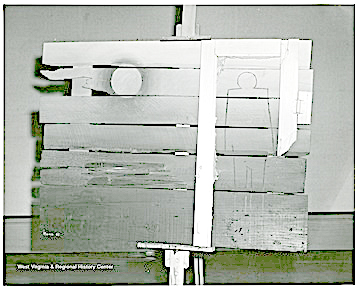By William “Skip” Deegans
 Of all the celebratory events during West Virginia’s centennial in 1963, the most memorable may be the West Virginia Exhibition of Painting and Sculpture. The exhibition was judged by James J. Sweeney, the former director of New York’s Guggenheim Museum. He was awarded first prize and a cash award of $1,963 to state native and West Virginia University professor Joe Moss for his painting “West Virginia Moon.” As shown in this week’s photo, Moss’ entry was made from weathered boards, an old screen door, and painted with some leftover paint.
Of all the celebratory events during West Virginia’s centennial in 1963, the most memorable may be the West Virginia Exhibition of Painting and Sculpture. The exhibition was judged by James J. Sweeney, the former director of New York’s Guggenheim Museum. He was awarded first prize and a cash award of $1,963 to state native and West Virginia University professor Joe Moss for his painting “West Virginia Moon.” As shown in this week’s photo, Moss’ entry was made from weathered boards, an old screen door, and painted with some leftover paint.
The award was met with a hue and cry heard all over West Virginia. Charleston’s mayor John Shanklin called the painting “atrocious” and “sickening.” Editorials in the Beckley Post-Herald and Raleigh Register described it as a “monstrosity,” recommended it be burned, and the publisher wrote that he was “disgusted” about the painting. There was concern it would tarnish West Virginia’s image. Even Dwight D. Eisenhower weighed in by remarking “…freedom of the arts is a basic freedom – that the artist must be free.” When the exhibition opened to the public at Huntington Galleries following the initial commotion, 3,000 people came to see “West Virginia Moon” on the first day.
Joe Moss left West Virginia to become a professor at the University of Delaware where he taught for 29 years. He died in 2018, and testimonials indicate he was a gifted and well-beloved teacher. The state bought “West Virginia Moon,” and it is exhibited at the State Museum in Charleston.
Photo courtesy of West Virginia Regional History Center.
Sources: Huntington Herald Dispatch, Beckley Post-Herald, Raleigh Register, West Virginia Public Broadcasting, Congressional Record.



